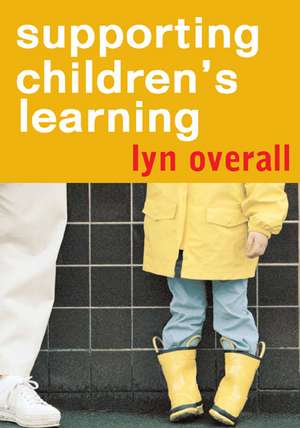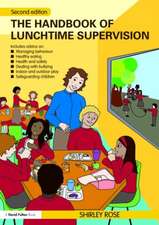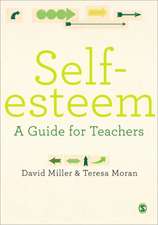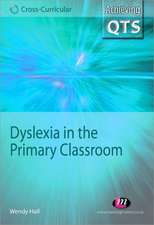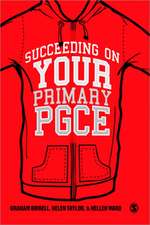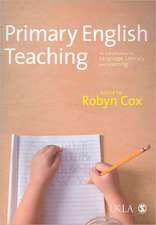Supporting Children's Learning: A Guide for Teaching Assistants
Autor Lyn Overallen Limba Engleză Paperback – 23 ian 2007
o An introduction to the main theories of learning and development, from birth to primary;
o A chapter on brain development;
o An introduction to what motivates learners to learn, and how much learners understand about how learning takes place;
o A glossary of key terms;
o Case studies, research summaries, tasks for reflection, chapter summaries and advice on further reading.
This book will be essential reading for Teaching Assistants studying for Foundation Degrees, or for the Higher Level Teaching Assistant qualification. Students on any course looking at how children learn (such as Early Childhood and teacher training courses) will likewise find this book covers all the key themes.
Lyn Overall is Principal Lecturer at Sheffield Hallam University.
Preț: 430.97 lei
Nou
Puncte Express: 646
Preț estimativ în valută:
82.47€ • 85.58$ • 68.94£
82.47€ • 85.58$ • 68.94£
Carte tipărită la comandă
Livrare economică 15-29 martie
Preluare comenzi: 021 569.72.76
Specificații
ISBN-13: 9781412912747
ISBN-10: 1412912741
Pagini: 160
Ilustrații: 1, black & white illustrations
Dimensiuni: 186 x 232 x 9 mm
Greutate: 0.3 kg
Ediția:1
Editura: SAGE Publications
Colecția Sage Publications Ltd
Locul publicării:London, United Kingdom
ISBN-10: 1412912741
Pagini: 160
Ilustrații: 1, black & white illustrations
Dimensiuni: 186 x 232 x 9 mm
Greutate: 0.3 kg
Ediția:1
Editura: SAGE Publications
Colecția Sage Publications Ltd
Locul publicării:London, United Kingdom
Cuprins
How to Use This Book
1 - LEARNING AND DEVELOPMENT
Theory, What's That?
The Big Themes
f003 Values and Beliefs
<i>Nativism Versus Empiricism?
Continuous or Discontinuous?
Stability or Change?
How is Theory Developed?
How is Theory Used?
Summary
Further Reading
2 - THE BRAIN AND LEARNING
What Is The Brain?
What Does The Brain Do?
Learning and the Brain
Brain Connections, Birth to One Year
Does The Brain Learn Some Things More Easily At Some Points?</i>
<i>Does The Brain Development Need A Rich And Varied Setting?
Summary
Further Reading
3 - THE SENSES AND LEARNING
Sensation and Perception
Studying Perception
Seeing
Hearing
Kinaesthesia
Making Sense
Visual Learning, Auditory Learning, Kinaesthetic Learning
Summary
Further Reading
4 - BIG THEORY 1: Skinner and the Behaviourists
What is Behaviourism?
The Behaviourists
Cat in a Box
Rat in a Box
Learning Through Imitation
Implications for Teaching
5- BIG THEORY 2: Piaget and the Constructivists
What is Constructivism?
The Work of Piaget
How Well Does This Theory Work?
Children's Social Development
What is Intelligence?
Information Processing
Implications for Teaching
6- BIG THEORY 3: Vygotsky and Social Constructivism
What is Social Constructivism?
Vygotsky's Theory
Implications for Teaching
Summary: Theories in the Classroom
7 - MANAGING LEARNING
What Is Learning?
Making Choices About Managing Learning
Longer Term Outcomes
What We Do To Help Learning?
Views about Learning
8 - MANAGING BEHAVIOUR
What Do We Mean By Managing Behaviour?
Views about Children and Young People
The Outcomes of Control and Guidance Approaches to Discipline
What Do We Do About Social and Emotional Development
Do Children and Young People Understand Social Behaviour?
Learning from Parents
Our Expectations about Conduct
Using Control Approaches
Praise and Blame
Do Control Approaches Work?
Using the Guidance Approach
1 - LEARNING AND DEVELOPMENT
Theory, What's That?
The Big Themes
f003 Values and Beliefs
<i>Nativism Versus Empiricism?
Continuous or Discontinuous?
Stability or Change?
How is Theory Developed?
How is Theory Used?
Summary
Further Reading
2 - THE BRAIN AND LEARNING
What Is The Brain?
What Does The Brain Do?
Learning and the Brain
Brain Connections, Birth to One Year
Does The Brain Learn Some Things More Easily At Some Points?</i>
<i>Does The Brain Development Need A Rich And Varied Setting?
Summary
Further Reading
3 - THE SENSES AND LEARNING
Sensation and Perception
Studying Perception
Seeing
Hearing
Kinaesthesia
Making Sense
Visual Learning, Auditory Learning, Kinaesthetic Learning
Summary
Further Reading
4 - BIG THEORY 1: Skinner and the Behaviourists
What is Behaviourism?
The Behaviourists
Cat in a Box
Rat in a Box
Learning Through Imitation
Implications for Teaching
5- BIG THEORY 2: Piaget and the Constructivists
What is Constructivism?
The Work of Piaget
How Well Does This Theory Work?
Children's Social Development
What is Intelligence?
Information Processing
Implications for Teaching
6- BIG THEORY 3: Vygotsky and Social Constructivism
What is Social Constructivism?
Vygotsky's Theory
Implications for Teaching
Summary: Theories in the Classroom
7 - MANAGING LEARNING
What Is Learning?
Making Choices About Managing Learning
Longer Term Outcomes
What We Do To Help Learning?
Views about Learning
8 - MANAGING BEHAVIOUR
What Do We Mean By Managing Behaviour?
Views about Children and Young People
The Outcomes of Control and Guidance Approaches to Discipline
What Do We Do About Social and Emotional Development
Do Children and Young People Understand Social Behaviour?
Learning from Parents
Our Expectations about Conduct
Using Control Approaches
Praise and Blame
Do Control Approaches Work?
Using the Guidance Approach
Descriere
Supporting Children's Learning: A Guide for Teaching Assistants explains all the key ideas on how children learn and how best to support children in that learning. Covering all major themes, this book offers an introduction to main theories of learning and development from birth to primary including brain and emotional and social development; an introduction to what motivates learners to learn, and how much learners understand about how learning takes place; a glossary of terms; and case studies, research summaries and tasks for reflection.
